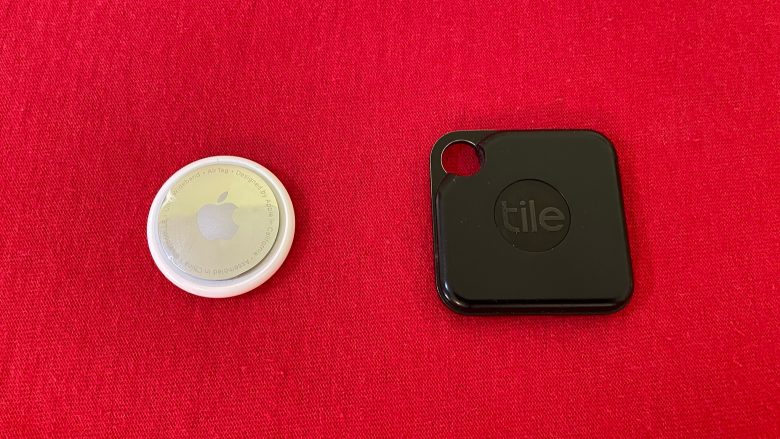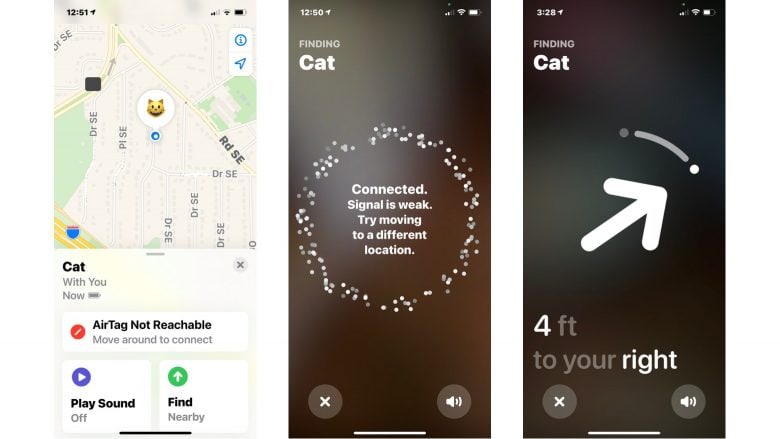Apple’s AirTag sales pitch is that you can attach the item tracker to your keys and you can find it with your iPhone, whether it’s in the couch or Canberra. That’s true, but the wireless range of these gizmos is so limited that finding a nearby AirTag in the next room isn’t easy as it should be. And the hardware is missing an obvious feature.
I’m a long-time user of rival Tile trackers. I was expecting Apple’s offering to be significantly better. In reality, both have their strengths. And Tile comes out ahead in some critical ways.
AirTag review
An AirTag is a flat, white-and-silver disk roughly 1.25 inches across and 0.2 inches thick. It’s about the same size as a coat button.
Though perhaps that’s a poor comparison because a button comes with an attachment method. That’s not true of AirTag. Apple didn’t put in a hole, so users must add a case to attach the tracker to anything.
This seems like a very cynical business decision. You can drop the tracker tag into a purse or bag, but for most uses, you’ll need to buy a holder with a ring or strap attached. Options range from a Belkin key ring that costs $12.95 to a leather Hermès model that’s a crazy $449.
Thank goodness there’s a removable cover that allows the AirTag battery to be replaced. And that should only be necessary once a year. Plus, the device is IP67 water- and dust-resistant.
In contrast to Apple’s design, Tile trackers come with holes in them. You can attach them to whatever you want without buying anything extra. They’re also waterproof and boast removable batteries.
That said, the Tile Pro I use doesn’t look as sleek as AirTag. Utilitarian is perhaps the best word.

Photo: Ed Hardy/Cult of Mac
AirTag performance
What’s supposed to set AirTag apart from the competition is ultra-wideband technology. With UWB, radio signals are broadcast across a broad swath of the radio spectrum. The distance and direction between the sender and receiver can be determined, making it a better tracking option than Bluetooth, which is what Tile depends on.
In real-world use, the wireless range of AirTag is very undependable. And that’s apparently because of the shape of the device. As mentioned, it’s a flat disc. My tests show it doesn’t do a good job broadcasting from the thin edge. If I lay one of Apple’s trackers flat on a table, I can‘t connect to it much past 30 feet. Prop the AirTag upright, though, and I get a solid connection 100-plus feet away.
The AirTag signal doesn’t travel well through walls, either. I can’t make a reliable UWB connection between two rooms.
That limits the usefulness of what’s supposed to be a strength of AirTag. The Find My app on a recent iPhone model can use UWB to show an arrow pointing to the item tracker. In my testing with an iPhone 12, that nifty trick generally worked within about 15 feet of the device. Maybe 20 feet. So it works in the hall outside the room where the tracker is, not in another room.
But the iPhone can make a non-directional connection to the AirTag. I’m assuming this is good old reliable Bluetooth. And with that connection, you can make the tracker repeatedly play a sound, then wander through your home listening for it.
So do not think you’re going to stand in your kitchen, pull out your iPhone, and see an arrow pointing to the AirTag attached to the keys in a pants pocket in your bedroom. That sort of thing happens only in TV commercials.
My testing shows Tile has a much longer range. I put the type types of tracker side by side and could get a strong connection to the Tile when I was beyond AirTag connection range.
Also — and this really matters — the Tile’s alarm is noticeably louder.
Very long-range connections
The real strength of AirTag is if an item gets really lost, not just misplaced inside your house. The tracker can be located by other people’s iPhones, Macs and iPads via Bluetooth. That means you can find that your AirTag is at the train station you left two hours ago, if someone with an iPhone wanders near it.
Even better, the users of the other Apple computers don’t have to do anything for this to work. There’s nothing to install but the most recent versions of iOS, macOS or iPadOS. That means there are hundreds of millions of devices that potentially could locate your lost sunglasses.
Tile does the same trick, but it doesn’t benefit from Apple’s enormous reach. The Tile app must be installed and running on someone’s phone or tablet to find your lost Tile. That’s a far smaller group to pull from. Still, Tile points out that it has sold 10 million trackers so far. And there are plenty of Tile users in well-populated areas.
Software
There’s disappointing about setting up an AirTag. Remove it from the packaging, hold it near your iPhone, and the two devices will connect. After that you just need to name the tracker.
And the pointing arrow used to find an AirTag is cool once you’ve used the tracker’s beeping to locate the right room. Open the Find My app on your iPhone 11 or 12 series, tap on the Items tab Apple added in iOS 14.5, then choose the tag from a list. Hit the Find button on the resulting page to pull up the pointer.

Screenshots: Ed Hardy/Cult of Mac
Let’s compare that to how AirTag’s archrival Tile works. Tile trackers use simple Bluetooth, so there’s never a nifty arrow pointing to your lost item. But, like AirTag, it can show you on a map the last known location of your tracker.
And Tile has a couple real software advantages. For one, a family can share an AirTag. So everyone can find the car keys or the TV remote.
And Tile offers an Android app. As long as AirTag works only with Apple devices, it’s never going to be a very serious Tile competitor.
AirTag final thoughts
When you’re looking for an item with an AirTag attached, you’ll be guided right to it if the tracker is close. And you have a pretty good chance of finding the item if it’s miles away, thanks to Apple’s network of users. Where AirTag is weak is when your lost item is 50 feet away, in another room.
But based on my years of using item trackers, that third situation is the one you’ll find yourself in the most often. Which is why I’m disappointed by AirTag.
To be clear, it’s not bad. It’s just not all that good. And the best I can say is it’s AirTag 1.0. There’s a lot of potential here. If the followup version has more range — and a simple hole — Apple will really have something.
In the meantime, Tile is still a solid competitor because it beats AirTag when you’re trying to find an item 50 feet away. And its hardware design is better, and it offers family sharing.
I thought Apple was going to revolutionize the item tracker market the same way it did with iPhone and iPad. I’m a fan of item trackers and I though Apple would make the one that would convince millions of people who never owned a tracker that they needed one. AirTag isn not that product. And that’s a disappointment.
Pricing
A single AirTag costs $29 from the online Apple Store. A pack of four runs $99.
I tested Apple’s tracker against a Tile Pro, which costs $34.99 on the Tile website. A pack of four costs $99.99.
![Apple AirTag is a disappointment [Review] Apple AirTag review. So small, so meh. And where’s the $%&# hole, Tim?](https://www.cultofmac.com/wp-content/uploads/2021/04/8D911B8D-3F52-45B0-B924-6038971E6D2F-1536x864.jpeg)

